Discover the rich traditional methods of processing cassava. Learn about fermentation, grating, drying, and more, and how these methods enhance flavor, nutrition, and sustainability in cassava production.
Traditional processing methods of cassava root tuber play a big role in preserving and boosting its nutritional value.
Techniques like fermentation, drying, and baking help break down harmful compounds in raw cassava, making it safer to eat and more nutritious.
These methods have been passed down through generations, reflecting the practical knowledge and cultural traditions of communities.
By understanding these processes, you can appreciate how the cassava crop supports food security and nutrition in many regions.
In this guide, you’ll learn about each step of traditional cassava processing, showing how it combines both skill and science to turn cassava into a reliable, healthy crop for millions of people around the world.

Table of Contents
- What are the Traditional Methods of Processing Cassava?
- Importance of the Traditional Methods of Processing Cassava
- Preliminary Steps in Traditional Methods and Techniques of Processing Cassava Roots
- Traditional Drying and Grating Methods of Processing Cassava Roots
- Traditional Starch and Flour Extraction from Cassava Root
- The Role of Traditional Methods of Processing in Sustainability
- How Traditional Methods of Processing Affect Cassava Nutritional Value
- Challenges in Traditional Methods of Processing Cassava
- Frequently Asked Questions
- Conclusion
What are the Traditional Methods of Processing Cassava?
Traditional methods of processing cassava involve a series of steps that make the root edible and safe for consumption.
The first step is harvesting, after which the tough outer skin and the roots to remove any dirt or contaminants.
Afterward, cassava is often fermented to break down harmful compounds like cyanide, making it safer to eat.
This fermentation process can last for several hours or even days, depending on the desired outcome.
Once fermented, the cassava is cut into smaller pieces and grated, either manually or with mechanical tools, to prepare it for further processing.
The grated cassava is then dried, usually through sun or air drying, which reduces moisture and extends its shelf life.
Thermal processing methods, such as roasting or boiling, are used to soften or crisp the cassava for various dishes.
Finally, the dried cassava is milled or ground into flour or starch, which is commonly used in a variety of food products.
The traditional method used in the processing of cassava depends on the desired end product.
These traditional methods not only preserve cassava but also enhance its nutritional value and make it a staple food in many cultures.
Importance of the Traditional Methods of Processing Cassava
The traditional methods of processing cassava are vital for several reasons, especially in regions where cassava is a major staple crop.
Making Cassava Safe for Consumption
Raw cassava contains harmful compounds like cyanide, which can be toxic if not properly processed.
Fermentation and other traditional techniques, such as boiling or roasting, break down these toxins, making the root safe for consumption.
This step is crucial in ensuring that cassava can be consumed without causing harm.
Enhancing Nutritional Value
Traditional processing methods also enhance the nutritional value of cassava.
Fermentation, drying, and thermal processing can increase the availability of important nutrients while reducing anti-nutritional factors that may inhibit the absorption of vitamins and minerals.
For instance, fermentation helps break down starches and enhances the digestibility of cassava.
Preservation and Food Security
Another crucial aspect is the preservation of cassava.
Through drying and fermentation, traditional methods extend the shelf life of cassava, making it easier to store and use throughout the year, particularly in regions where fresh produce may not always be available.
This contributes significantly to food security, ensuring that communities have access to food during lean periods.
Supporting Local Economies and Cultural Heritage
Traditional methods support local economies and help preserve cultural heritage.
By relying on practices passed down through generations, communities not only create jobs but also maintain their agricultural traditions, encouraging a sense of pride and connection to their history.
These methods are an integral part of the local culture and identity.
Sustainability and Environmental Benefits
Finally, the traditional processing of cassava is more sustainable compared to industrial methods.
It often requires fewer resources, such as electricity or machinery, making it more environmentally friendly and accessible for small-scale farmers.
This sustainable approach also promotes a stronger relationship with the land, as communities use locally available resources to process cassava in an eco-conscious manner.
Related Posts
Compact Cassava Processing Units
How to Process Cassava with Modern Machines
How to Set Up a Cassava Ethanol Production Plant
What is Tapioca? Types and Applications
Tools and Equipment for Cassava Processing
Grated Cassava – Recipe, Uses and How to Grate
Mechanized Cassava Peeling Equipment
Preliminary Steps in Traditional Methods and Techniques of Processing Cassava Roots
Harvesting Cassava
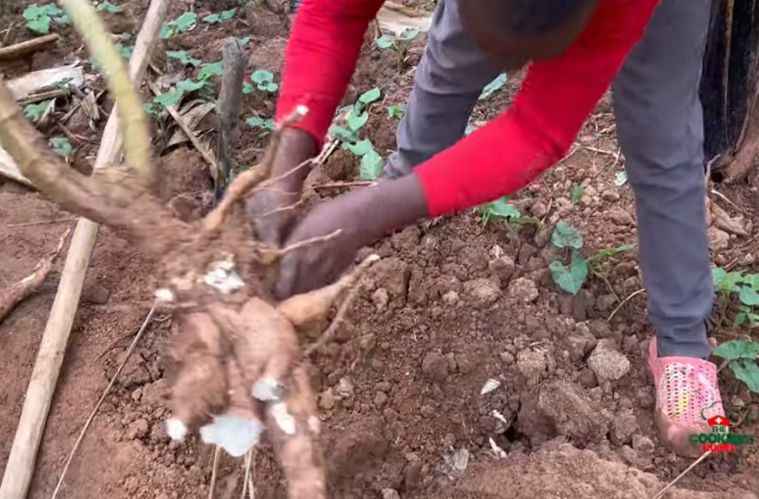
Harvesting cassava is key to its quality and yield. The optimal harvest time is 8 to 24 months after planting, depending on root size and foliage health.
Healthy leaves indicate maturity, and well-drained soils promote better root growth.
Using the right tools, like a spade or fork, helps prevent root damage.
Harvesting during dry weather is ideal to avoid root deformation.
A systematic approach, starting from the base and moving outward, reduces plant disturbance.
After harvesting, cassava should be handled carefully to prevent bruising, which affects market value and shelf life.
Proper practices ensure higher yields and quality cassava for processing.
Here is an in-depth, dedicated article on how to harvest cassava roots.
Cassava, a root crop common in tropical areas, goes through several traditional processing methods that make it safe and nutritious to eat. Let’s break down the key steps:
Peeling and Washing
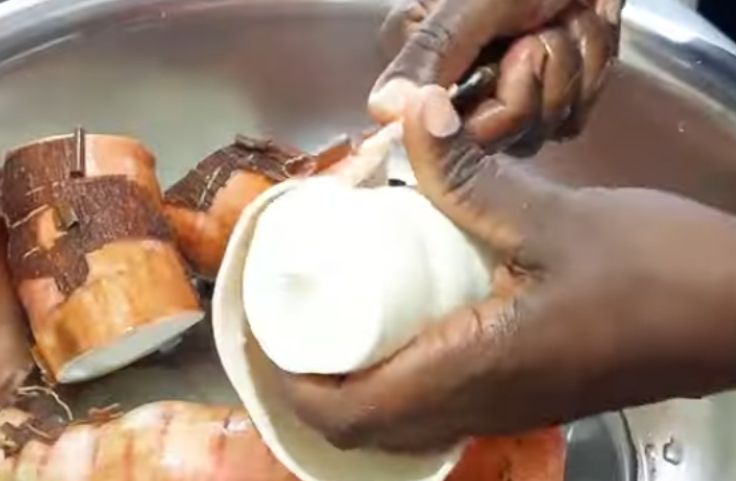
The next step in the traditional processing of cassava root is peeling off the tough outer skin.
This is typically done using a knife or a similar tool.
The technique varies across regions, with some cultures using special tools or methods that have been passed down for generations.
After peeling, the cassava roots are carefully washed to remove any dirt, soil, or impurities.
This ensures that the roots are clean and hygienic, preparing them for the next stages of processing.
Thorough washing is essential to ensure that any contaminants are removed, promoting safety and quality during the rest of the preparation process.
Cutting/Grating the Cassava Roots
Cutting

Once the cassava has been washed, it is cut into smaller, manageable pieces.
This step is important for two main reasons: to make the cassava easier to cook and to prepare it for further processing, like fermentation.
Cutting the cassava into uniform sections allows for more even cooking and reduces preparation time.
The size of the pieces varies based on regional preferences, with some cultures chopping the roots into larger sections, while others prefer smaller pieces.
The cutting process can also impact the texture of the final product, contributing to the desired consistency in traditional dishes.
Grating/Grinding

Also, the cassava can be grated immediately after peeling and washing if it will be used for garri production.
In my cassava farming community, our major cassava products are garri and fufu.
Grating or grinding the cassava root is made possible with the use of a grating machine that is locally produced.
The machine grinds the fresh tubers into pulp, after which it is bagged with porous or mesh bags for draining and fermentation.
See more on how to process cassava for garri.
Fermentation Process
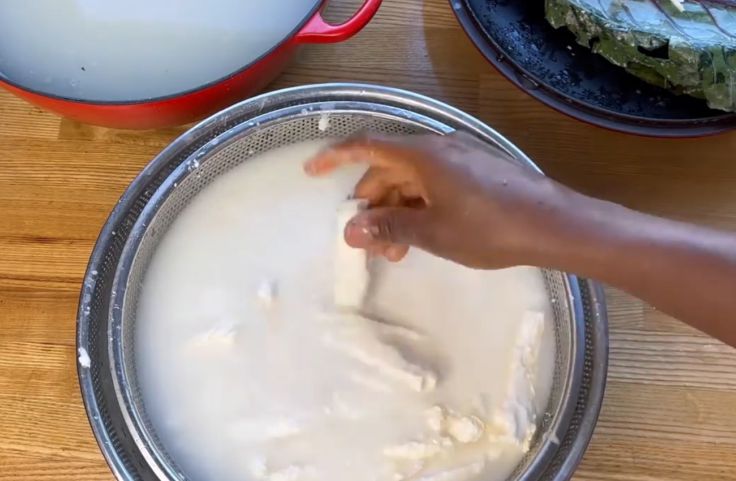
Fermentation is a crucial step in the traditional processing of cassava.
It helps eliminate toxic substances like cyanogenic glucosides, which are naturally present in raw cassava and can be harmful if not properly processed.
In some areas, the cassava is soaked in water for some time to allow fermentation to occur.
In other regions, fermentation happens naturally through environmental microorganisms.
This process not only detoxifies the cassava but also improves its flavor and texture, which is key for creating many traditional dishes.
Fermentation gives cassava a distinctive taste and makes it safer for consumption by breaking down harmful compounds.
Traditional Drying and Grating Methods of Processing Cassava Roots
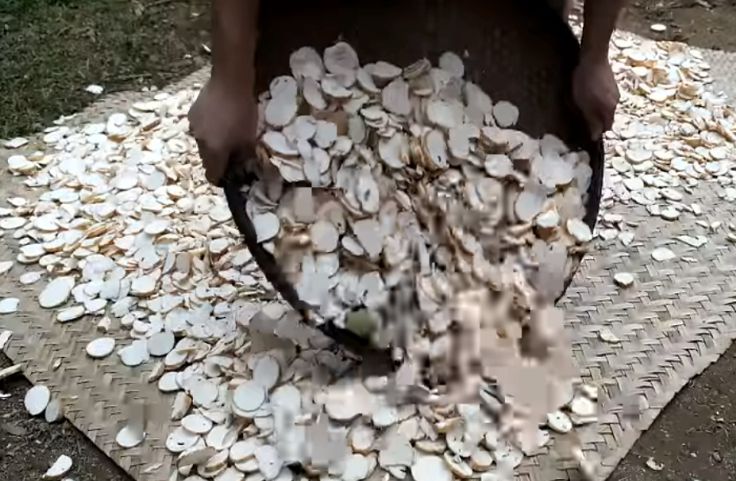
Traditional Drying Methods
Drying cassava is an important step in traditional processing, ensuring longer shelf life and improved quality.
Different drying methods affect texture, safety, and preservation, making the choice of technique essential for optimal results.
Sun-Drying Cassava Roots
Sun-drying is the most common traditional method for preserving cassava.
It involves spreading cassava slices in direct sunlight for several hours or days, allowing moisture to evaporate naturally.
This method is inexpensive and relies on renewable energy, making it accessible in rural areas with limited resources.
However, it depends on weather conditions, and there is a risk of contamination from dust, insects, and animals.
Despite these challenges, sun-drying remains a widely used technique due to its simplicity and effectiveness in extending the shelf life of cassava.
Air-Drying for Controlled Drying
Air-drying is another method used to dry cassava in well-ventilated areas.
Unlike sun-drying, this approach provides better control over the drying process, reducing exposure to contaminants.
It helps maintain cassava quality and lowers the risk of spoilage.
However, air-drying takes more time and may require additional energy if artificial ventilation is used.
This method is ideal for ensuring an even drying process, preserving the integrity of cassava while minimizing external contamination.
Traditional Grating of Cassava Roots
Grating is one of the essential traditional methods of processing cassava, helping to break down the dried roots for further use.
Whether done manually or mechanically, the method you choose affects texture, efficiency, and nutrient retention.
Manual Grating
After drying, the next step is grating, which is necessary to prepare cassava for various dishes.
You can choose to grate cassava manually or mechanically, depending on your resources and the desired texture.
Manual grating involves using hand-held graters, which allow for more control but are labor-intensive.
This method results in a coarser texture, preserving more nutrients in the cassava.
It’s a great option if you’re aiming for a more traditional and hands-on approach.
Mechanical Grating
On the other hand, mechanical graters offer speed and efficiency.
They can process large amounts of cassava in a short time and provide more uniform results.
Depending on the machine’s settings, you can achieve a fine or coarse texture.
However, this method may lead to a slight loss in nutrients, as the process is faster and might not retain as much of the cassava’s natural goodness as manual grating.
Thermal Processing Methods

Thermal processing is a part of the traditional technique of cassava preparation, affecting texture, taste, and nutritional value.
Different methods, such as boiling, steaming, and roasting, offer unique results depending on how you plan to use the cassava.
Boiling
Boiling softens cassava, making it easier to eat. It’s a common method for preparing cassava for direct consumption.
Boiled cassava pairs well with various dishes, and is a simple way to prepare it, ready for eating.
Steaming
Steaming is gentler than boiling and helps preserve more nutrients.
This method is ideal when you want to retain cassava’s natural goodness while ensuring a soft and edible texture.
Roasting/Baking
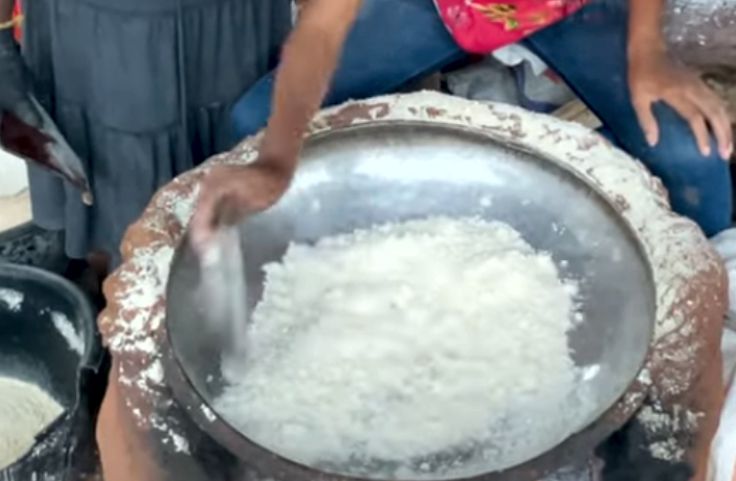
Roasting, commonly used for making garri, enhances cassava’s flavor and texture.
It creates a crispy, aromatic final product that is perfect for various traditional dishes.
Related: How to Cook Cassava Roots
Traditional Starch and Flour Extraction from Cassava Root
Traditional methods of processing cassava transform this root crop into useful ingredients like starch and flour.
These methods have been passed down through generations, supporting food production and preserving cultural practices.
Wet Starch Extraction
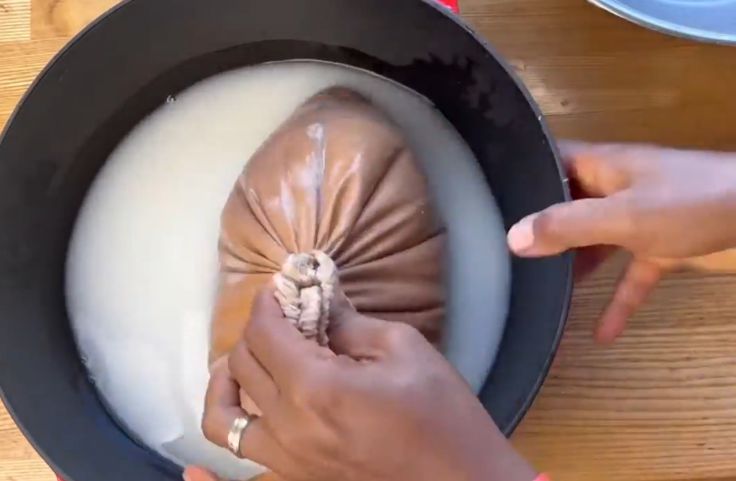
To extract the cassava starch, sometimes called tapioca, start by soaking peeled cassava roots in water. This softens the fibers and helps release starch granules.
Once softened, grate or pound the cassava into a slurry. The mixture is then washed thoroughly to separate the starch from the fibrous material.
After settling, the starch is drained, dried, and stored for later use.
This method produces fine, high-quality starch used in making fufu, tapioca and as a thickening agent in soups and sauces.
The wet extraction process results in a more refined starch that blends well into various recipes and food preparations.
Dry Milling for Flour
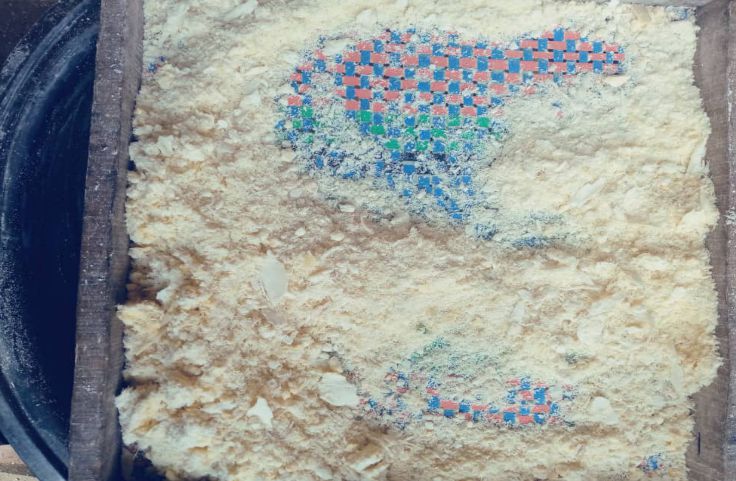
In dry milling, cassava slices are dried either under the sun or using mechanical dryers before grinding them into cassava flour.
Proper drying is important because it reduces moisture, preventing spoilage and extending shelf life.
Once dried, the cassava is ground into fine or coarse flour, depending on the intended use.
This flour is a staple in baking, used for making bread, pastries, and other food products.
It can also be mixed with other flours for a better texture and nutritional value.
Dry milling is a practical method that preserves cassava while making it more versatile for everyday cooking. See more on how to make cassava flour.
The Role of Traditional Methods of Processing in Sustainability
Traditional methods of processing cassava support both local communities and the environment.
It relies on simple methods that use local resources, reduce waste, and minimize pollution.
Unlike industrial techniques, these processes have a lower carbon footprint and promote long-term sustainability.
Low-Impact Processing Methods
Techniques like sun drying and fermenting require little to no electricity.
By using natural elements, such as sunlight and air, you save energy while maintaining the quality of cassava products.
These methods have been passed down for generations, preserving knowledge and ensuring that communities remain self-sufficient.
Preserving Biodiversity and Soil Health
Traditional cassava varieties thrive under sustainable farming practices.
By growing and processing cassava using time-tested methods, you help maintain soil fertility and protect local ecosystems.
Small-scale farmers who follow these practices avoid excessive chemical use, keeping the land productive for future harvests.
Strengthening Communities and Food Security
Processing cassava traditionally is often a communal effort.
Families and neighbors come together to peel, dry, and grind cassava, strengthening social ties while ensuring a steady food supply.
These methods also create local job opportunities, reducing dependency on imported food and supporting economic resilience.
Sustainable cassava processing is more than a practice; it’s a commitment to preserving culture, protecting the environment, and securing livelihoods.
By choosing these time-honored techniques, you contribute to a healthier planet and stronger communities.
How Traditional Methods of Processing Affect Cassava Nutritional Value
Cassava provides energy and essential nutrients, but its raw form contains cyanogenic compounds that can be harmful.
Traditional processing techniques like fermenting, soaking, and drying help make cassava safer and more nutritious.
Removing Harmful Compounds
Fermentation and soaking allow natural enzymes to break down cyanide, reducing toxicity by up to 90%.
Drying further eliminates residual toxins, ensuring cassava is safe to eat.
These methods make cassava a reliable food source, especially in regions where it is a staple.
Improving Digestibility and Nutrient Absorption
Soaking and fermenting cassava enhances its digestibility by breaking down complex starches.
This makes cassava easier on your digestive system while increasing the bioavailability of nutrients like iron and zinc.
The fermentation process also promotes gut-friendly bacteria, contributing to better digestion.
Retaining Nutrients Compared to Modern Processing
Unlike industrial methods that strip away fiber and micronutrients, traditional processing preserves essential elements.
Sun drying, for example, maintains vitamin C levels, while fermentation boosts B vitamins.
These natural techniques ensure that cassava retains its nutritional benefits without relying on additives.
Challenges in Traditional Methods of Processing Cassava
Traditional methods of processing cassava bring unique challenges that can affect both the quality and efficiency of the final products.
While these methods have been passed down through generations, they come with limitations that require attention.
Labor-Intensive Nature of Processing
Traditional methods of processing cassava rely heavily on manual labor, which can be physically demanding.
From peeling to fermenting and drying, each step requires a significant amount of time and effort.
This slows down production and often leads to variations in product quality.
Unlike mechanized methods, traditional processes are not as fast or uniform, making it harder to maintain consistent results.
Inconsistent Quality Control
Without standardized procedures, the quality of traditionally processed cassava can vary greatly.
For example, fermentation, a key process, can produce different flavors and textures based on temperature, humidity, and the skill of the person doing the work.
These fluctuations can result in subpar products like flour or chips, leaving you with inconsistent quality.
Environmental Factors and Climate Risks
Changes in weather patterns, pests, and diseases significantly affect cassava crops.
Climate change can make cassava yields unpredictable, reducing both quantity and quality.
Pest infestations can destroy crops, creating further difficulties for farmers who may not have the resources to protect or replant their fields.
In short, traditional methods of processing cassava face challenges that need to be addressed to maintain the quality and availability of cassava-based foods.
Adapting to these challenges is important to ensure the crop’s future sustainability.
Frequently Asked Questions
Why is cassava fermented?
Fermentation removes toxic compounds like cyanide, making cassava safe to eat and enhancing its flavor and texture.
What are the drying methods for cassava?
Sun-drying and air-drying help preserve cassava by reducing moisture content, extending shelf life, and maintaining quality.
How do traditional methods of processing cassava contribute to sustainability?
It relies on low-energy, eco-friendly techniques like sun-drying and fermentation, promoting sustainability and reducing environmental impact.
Why is cassava processed manually?
Manual processing, like grating, is often more controlled, retaining nutrients and maintaining traditional practices while supporting local economies.
Conclusion
Traditional methods of processing cassava play a central role in turning this supercop root into safe, nutritious, and sustainable cassava products like garri, fufu, flour, and starch.
The methods of fermentation, drying, and grating not only preserve cassava but also enhance its nutritional value, ensuring it is safe for consumption and retains essential vitamins and minerals.
These techniques contribute to food security, cultural heritage, and local economies, while their environmentally friendly approach fosters sustainability.
By understanding these traditional practices, we can appreciate the ingenuity passed down through generations that continue to support millions of people worldwide.
References
- FAO: Processing of Roots and Tubers
- IITA: Traditional Processing and Utilization of Cassava Roots in Africa

Chimeremeze Emeh is a writer and researcher passionate about Africa’s most transformative root crop—cassava. Through his work at cassavavaluechain.com, he explores the entire cassava industry, from cultivation and processing to its diverse applications in food, health, and industrial use.
He also writes for palmoilpalm.com, where he shares his extensive experience and deep-rooted knowledge of palm oil, covering red palm oil, palm kernel oil, and refined products. His work there reflects his lifelong connection to agriculture and his commitment to promoting sustainable value chains in Africa.
Driven by curiosity and purpose, Chimeremeze aims to shed light on how cassava continues to empower communities, strengthen food systems, and link traditional farming wisdom with modern innovation.

